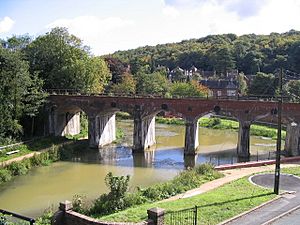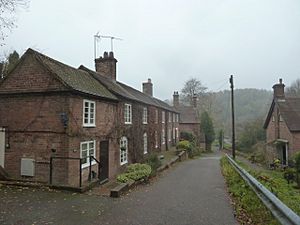Resolution (beam engine) facts for kids
Quick facts for kids Resolution |
|
|---|---|
| Origins | |
| Type | Atmospheric beam engine |
| Designer | James Watt |
| Maker | Boulton and Watt |
| Date | 1781 |
| Country of origin | England |
| Former operator | Coalbrookdale Company |
| Purpose | Water-returning engine driving machinery |
| Measurements | |
| Cylinders | 1 |
| Bore | 67 inches (170 cm) |
| Preservation | |
| Working | No |
The Resolution was a very early type of beam engine. It was built between 1781 and 1782 in a place called Coalbrookdale in England. Its main job was to pump water. This helped power the big furnaces and ironworks there.
This engine was one of the last "water-returning" engines ever made. Soon after, newer, more advanced engines came along. These new engines could turn wheels directly, making the Resolution's job less common.
Contents
Why Was Water Power Important in Coalbrookdale?

Coalbrookdale was a very important place during the First Industrial Revolution. This is where Abraham Darby I first made iron using coke instead of expensive charcoal. The valley at Coalbrookdale was steep and narrow. This was great for using water power. Water could drive the furnace blast (air for the furnace) and other machines.
People who visited often talked about the beautiful waterfalls. Even though there seemed to be lots of water, it was a problem. In summer, there wasn't enough water. This meant the furnaces had to stop working for months.
A simple way to have more water was to build ponds high up in the valley. These ponds stored water for short dry spells. But they couldn't provide enough water for a whole summer.
How Did Water-Returning Engines Help?
From 1735, the Coalbrookdale Company tried to solve the water problem. They used "water-returning engines." These engines didn't power the ironworks directly. Instead, they pumped water from lower ponds back up to higher ponds. This recycled the water.
The first engine was powered by horses around 1735. Later, a Newcomen engine replaced it in 1742–1743. Newcomen engines used a lot of coal. So, they were mostly used in coal mines where waste coal was cheap. At Coalbrookdale, they used good quality coal for these engines.
To pump even more water and use less coal, Abraham Darby III decided to upgrade. In 1781, he replaced the old Newcomen engine with the Resolution. This new engine was much more efficient.
How Was the Resolution Engine Built?
The Resolution engine was built by a famous company called Boulton and Watt. The engine had a very large cylinder, about 67 inches wide. This was big for its time. It worked using the "atmospheric principle" like older Newcomen engines. But it was improved by Watt's separate condenser, which made it more efficient.
The engine's boiler was shaped like a wagon and was 22 feet wide. The main part of the engine was a huge wooden beam. It was made from eight large oak trees joined together. This made it very strong. The beam moved up and down, pulling chains to power the pump.
The water pump itself had two cylinders, each 26 inches wide. It could pump 315 gallons of water with each stroke. That's about 2,235 gallons every minute! It was one of the biggest engines ever built then. It used about 200 hundredweight of coal every day.
The engine was named Resolution after Captain Cook's ship, HMS Resolution. He had recently sailed on voyages to the South Seas.
Why Did the Engine Become Outdated Quickly?
The Resolution became a bit old-fashioned soon after it was built. In 1782, James Watt made two big improvements to steam engines. He invented "double-acting" engines and the "rotative beam engine." These new engines could do more work and turn wheels directly.
Even so, single-acting engines like the Resolution were still used for pumping water from mines for over a hundred more years.
Where Was the Resolution Engine Located?
The Resolution engine was placed at the top of Coalbrookdale valley. It was between two ponds: the Upper Furnace Pool and the New Pool. This spot was higher up the valley than the old Newcomen engine. The old engine had supplied the Lower Furnace Pool.
Pumping engines from this time used a long vertical rod to lift water. They were good at lifting water from deep underground. But they couldn't push water very far at the top. So, the engine had to be placed close to where the water was needed.
The water that the Resolution pumped came from a lower pond called the Boring Mill Pool. This pond was made bigger when the engine was installed. An underground tunnel, about half a mile long, was dug from this pond to the engine house. The tunnel sloped slightly downhill to help the water flow. At the pump, the shaft was 120 feet deep. This tunnel was just one of many waterways built at Coalbrookdale around that time.
The Resolution engine worked for almost 40 years. By 1821, the engine house was already starting to fall apart.
The Resolution in Art
The artist Philip James de Loutherbourg sketched the working engine. He did this either in 1786 or 1800.
We know the engine was taken down around 1821. This is because J Homes Smith painted it that year, showing it partly demolished.
Images for kids



